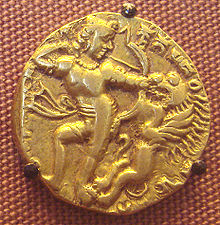
Back Kumaragupta I. ALS প্রথম কুমারগুপ্ত Bengali/Bangla Kumáragupta I. Czech Kumaragupta I. German Kumaragupto la 1-a Esperanto Kumaragupta I Spanish Kumâragupta Ier French कुमारगुप्त प्रथम Hindi Kumaragupta I. Croatian Կումարագուպտա I Armenian
| Kumaragupta I | |
|---|---|
| Maharajadhiraja Parama-bhattaraka Paramadvaita Mahendraditya | |
 Kumaragupta fighting a lion, as depicted on his gold coin[1] | |
| Gupta Emperor | |
| Reign | c. 415 – c. 455 CE |
| Predecessor | Chandragupta II |
| Successor | Skandagupta |
| Died | c. 455 CE |
| Spouse | Anantadevi |
| Issue | Skandagupta Purugupta |
| Dynasty | Gupta |
| Father | Chandragupta II |
| Mother | Dhruvadevi |
| Religion | Hinduism |
| Gupta Empire 320 CE–550 CE | ||||||||||||||||||||||||||||||||||||
|---|---|---|---|---|---|---|---|---|---|---|---|---|---|---|---|---|---|---|---|---|---|---|---|---|---|---|---|---|---|---|---|---|---|---|---|---|
|
||||||||||||||||||||||||||||||||||||
Kumaragupta I (Gupta script: ![]()
![]()
![]()
![]()
![]() Ku-ma-ra-gu-pta,[2] r. c. 415–455 CE) was an emperor of the Gupta Empire of Ancient India. A son of the Gupta emperor Chandragupta II and Queen Dhruvadevi. He seems to have maintained control of his inherited territory, which extended from Gujarat in the west to Bengal region in the east.
Ku-ma-ra-gu-pta,[2] r. c. 415–455 CE) was an emperor of the Gupta Empire of Ancient India. A son of the Gupta emperor Chandragupta II and Queen Dhruvadevi. He seems to have maintained control of his inherited territory, which extended from Gujarat in the west to Bengal region in the east.
Kumaragupta performed an Ashvamedha sacrifice, which was usually performed to prove imperial sovereignty, although no concrete information is available about his military achievements. Based on the epigraphic and numismatic evidence, some modern historians have theorized that he may have subdued the Aulikaras of central India and the Traikutakas of western India. The Nalanda mahavihara was possibly built during his reign.
The Bhitari pillar inscription states that his successor Skandagupta restored the fallen fortunes of the Gupta family, which has led to suggestions that during his last years, Kumaragupta suffered reverses, possibly against the Pushyamitras or the Hunas. However, this cannot be said with certainty, and the situation described in the Bhitari inscription may have been the result of events that happened after his death.
- ^ CNG Coin [1]
- ^ Allen, John (1914). Catalogue of the coins of the Gupta dynasties. p. 61.

